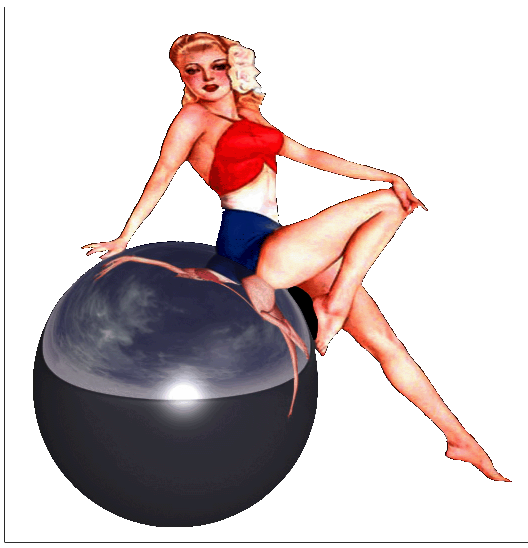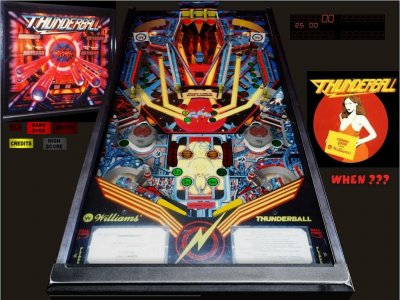Gaston, TAB, Destruk
IPD No. 2554
Rules:
IPD No. 2554
Rules:
Special thanks to Jay Stafford, "Dangerous Dann" Frank, and special thanks to Christopher Hubbard. Each owns a Thunderball machine and they supplied information and roms for the game.
To launch a ball, press KeyUpperLeft (by default is: A ) for the left shooter, KeyUpperRight (by default is: ' ) for the right shooter.
Refer to the document files which should be included in the original archive before attempting mods to the table - they may supply some added insight into how the game works for you, but some switches and lamps listed are incorrect. I have corrected them in the vpt file already.
***********************
Rules from printed documentation supplied with Christopher Hubbard's machine (The only copy of printed documentation known to exist.):
Credit Posting - Insert coins. A sound is produced and the number of credits is displayed. If the maximum credits are posted correctly, the coin lockout relay
de-energizes until the remaining credits are below maximum. No credit may be won and coins are rejected while the lockout is de-energized.
Game Start - Two balls must be resting on the ball ramp or ball shooter switches (maximum of one ball in the ball shooter trough) before the game will start. Push the credit button. A start-up tune is played, the ball is served, the credit display is reduced by 1, the player 1 score flashes 00 until the first scoring switch is made, and BALL IN PLAY shows 1. Pushing the credit button again before ball 2 is displayed allows additional players.
Scoring Multiplier - Advance the Scoring Multiplier (2X-3X-4X-5X) in a regular wave by bumper action or by scoring all six banks. Lighting the multiplier adds 10 seconds to Superwave time.
Targets - Score all 6 target banks for Superwave time. Any target in a flashing bank scores the complete bank. Hitting the roving flashing target scores a bank lamp for another bank.
Reload Holes - Lit Reload holes return the ball. Flashing Reload holes score a bank lamp and return the ball.
Superwave Time - Score all six banks for Superwave time. In Superwave time, unlimited balls are automatically fed onto the playfield. Lighting all six bank lamps advances the Superwave scoring multiplier (2X-3X-4X-5X).
Tilt - The ball in play is tilted on the first closure of the ball roll tilt and third* closure of the plumb bob and playfield tilts. The slam tilt returns the game to Game Over mode.
End of Game - Match digits* appear in the ball-in-play display and credit* is awarded for a match. Exceeding the high score to date awards three* credits. Match, High Score to Date and Game Over sounds are made as appropriate. A new game cannot be started with more than one ball in the ball shooter trough. Excess balls must be returned to the playfield and must drain to rest on the ball ramp switches.
THUNDERBALL SPEECH MODULE
PHASE WHERE IT OCCURS
Play Thunderball Attract mode and during Superwave time.
Player One During 2-player games.
Player Two Up During 2-player games.
5-4-3-2-1 (1) beginning of each wave (e.g. "five ball").
(2) when ball is fed (e.g. "last ball"
Superwave Beginning of Superwave time.
Fire Away Beginning of Superwave time.
40-30-20-10 seconds End of Superwave time.
5-4-3-2-1 End of Superwave time.
Reload Every time ball is added
* Indicates adjustable features.
-------------------------------------------
Jay Stafford's Rulesheet
From pinGame journal Issue #35 November, 1994
By The Power Invested In Me, I Now Pronounce You ...
THUNDERBALL!
By Jay Stafford, Phoenix AZ
In 1982, Williams experimented in producing a game designed to marry the "video game wave concept" with pinball. The play would become increasingly difficult as the player progressed. Like video games, the player's skill would be rewarded with additional "lives," tallied by a balls-to-play counter, yet also be awarded replays for high scores. This unique two-player talking game is called Thunderball, and only ten machines were produced. It features six-ball Multiball and even has gobbleholes!
Designed by Mark Ritchie, Thunderball is clearly a shooter's game, yet remains basic enough for the novice. The ball is served, not by a plunger, but via a set of "in-lanes" that deliver the ball from beneath the playfield to roll in front of the flippers for a controlled opening shot. An extra set of flipper buttons (I call them "Fire Buttons"), one on each side of the cabinet next to the regular flipper buttons, allows the player to choose which in-lane will serve the ball, and thus which flipper will get the shot.
The symmetrical playfield sports seven gobbleholes and six banks of targets. On each side of the upper playfield are a five-bank of drop targets and a two-bank of standing targets. Most dramatic is the fifteen-inch center ramp formed by elevating a section of playfield. Three gobbleholes await the player's ball at the top of the ramp, and a three-bank of standing targets line each side. All six banks are numbered and have a corresponding numbered playfield insert located at playfield center.
Play starts out in what is called "Regular Wave" with all bank targets reset. Completing each bank ("scoring" a bank) lights its numbered insert. Lighting all six inserts begins the Multiball mode called "Superwave." Superwave starts a timer (mine is set for 30 seconds) and allows unlimited balls to be played in that time, similar to the bonus round of Williams' Black Knight. Completing all six banks during Superwave lights 2X Superwave scoring, with repeated compilations earning up to 5X scoring and increasing the timer by 10 seconds.
It may seem impossible to achieve 5X in 30 seconds, but
assisting you is the frenzy of several balls flying around the
playfield. The neat thing about this game's Multiball is that, using the Fire Buttons, the player can control the number of balls in simultaneous play, up to a maximum of six. This helps when you need a skill shot to be uninterrupted by the other careening orbs. (Former Williams programmer, John Kotlarik told me that he and Ritchie decided on the six-ball idea with no thought to Balls-A-Poppin' of the then contemporary Centaur). When Superwave time expires, the playfield action goes dead as all balls drain and player-up advances, returning game play to single-ball Regular Wave.
A wide horseshoe lane at the very top of the playfield loops under and behind the ramp, with a spinner flag at each entrance. Shoot the ball into the horseshoe fast enough and it comes back out the other side. Too soft a shot drains behind the ramp. This is because the hidden part of the horseshoe is actually a narrow ledge (patent applied for at the time but not received) requiring sufficient centrifugal force to keep the ball from falling off and exiting the playfield. Which brings me to discuss the seven gobbleholes. Two are the potential drains from the horseshoe, three more on the ramp, and two more mid-way on each side of the playfield. Before I first saw this game, I thought I had seen the last of the gobblehole with 63's
Sweet Hearts, so I was sure that seven of those little buggers would be asking too much.
Not to worry! If the ball drains in any gobblehole when lit
for "Reload," you get your ball back via the Fire Button. The number of holes lit for reload depends on the number of reloads tallied on the backglass display. One reload is awarded every 200,000 points.
Player-up advances only at the completion of Superwave. If that is not achieved before draining, the Balls-to-Play counter will decrement, but the same player will be served the next ball. The possibility exists that Player 1 could complete an entire game in Regular Wave before Player 2 has even begun. If Superwave is completed, sucessive ones become harder to achieve.
This is because "scoring a bank" of targets initially only
requires that any one target in the bank be hit. The next Regular Wave will allow only two of six banks to qualify at any given time, lighting them in pairs: Banks one and two light together as Sector 1, banks three and four then light together as Sector 2, and banks five and six next light together as Sector 3. The Sectors take turns being lit and only one target in a lit bank need be hit to score the entire bank. The third Regular Wave lights all Sectors simultaneously, but this time, all targets in a bank must be hit to score that bank. The fourth Regular Wave lights all Sectors, but all targets must be hit in a particular sequence. Subsequent Waves subtly increase the
difficulty in scoring banks, but I think you get the idea. Also, each gobblehole lit for reload, while the reload lamp is flashing, will score a bank in addition to returning the ball to play.
The jet bumpers are nestled close to rebound switches and, during Regular Wave, sustained action between jet bumper and rebounds will increase scoring multipliers up to 4X. After the ball leaves the jet bumper area, the multipliers stay in effect proportionately: The longer the jet action, the longer it takes for the multipliers to countdown backwards from 4X to 3X to 2X to regular scoring. The original design for this game was to have all the targets as drop targets, but it overtaxes the hardware electronics in use at that time.
At first, the developers were not sure if the problem was
hardware or software, and the time spent on this problem took a lot of money out the development budget. At a time when video games were taking over pinball machines, cost efficiencies forced the decision not to put Thunderball into full production.
I want to point out that most references state describe
Thunderball as a four-player game. The confusion may have resulted from viewing the backglass while the game is off. It has four full-size displays, but two of them are used to tally each player's balls-to-play and reloads. Also, my research has shown me that this game should be listed with a 1982 date of production, instead of 1983 as usually stated. In fact, my playfield edge is stamped "Apr 1982."
There were three PROM versions for this game spread over the ten games built. I have the third version in mine and the only version, I am told, that does not let the game crash dead in the middle of playing it.
I've been unable to track down the existence of four of the ten games made and would like to hear from any other owners. I am trying to build paperwork on this game, as none was produced. At this time, I would like to thank Ted Estes, John Kotlarik, and Mark Ritchie for their help in this effort.
Artist Connie Mitchell did three backglasses and two
playfields for this game. The first backglass was a promotional
advertisement saying, "Coming in the Spring..." The second version was known as Thunderball I and showed a helmeted woman with shoulder pads and spiked gloves. She was to enter an arena and fight for the Thunderball trophy. This version may have been Williams' first four-color backglass. The last version, named Thunderball II, depicts a large pinball erupting little pinball orbs. All the playfield inserts are the ribbed or faceted style which enhances the aesthetic appeal, especially in attract mode. No knocker on this game; high
score replays are announced by a robust male voice inviting you to "Play Thunderball!"
- ROM------------------>


